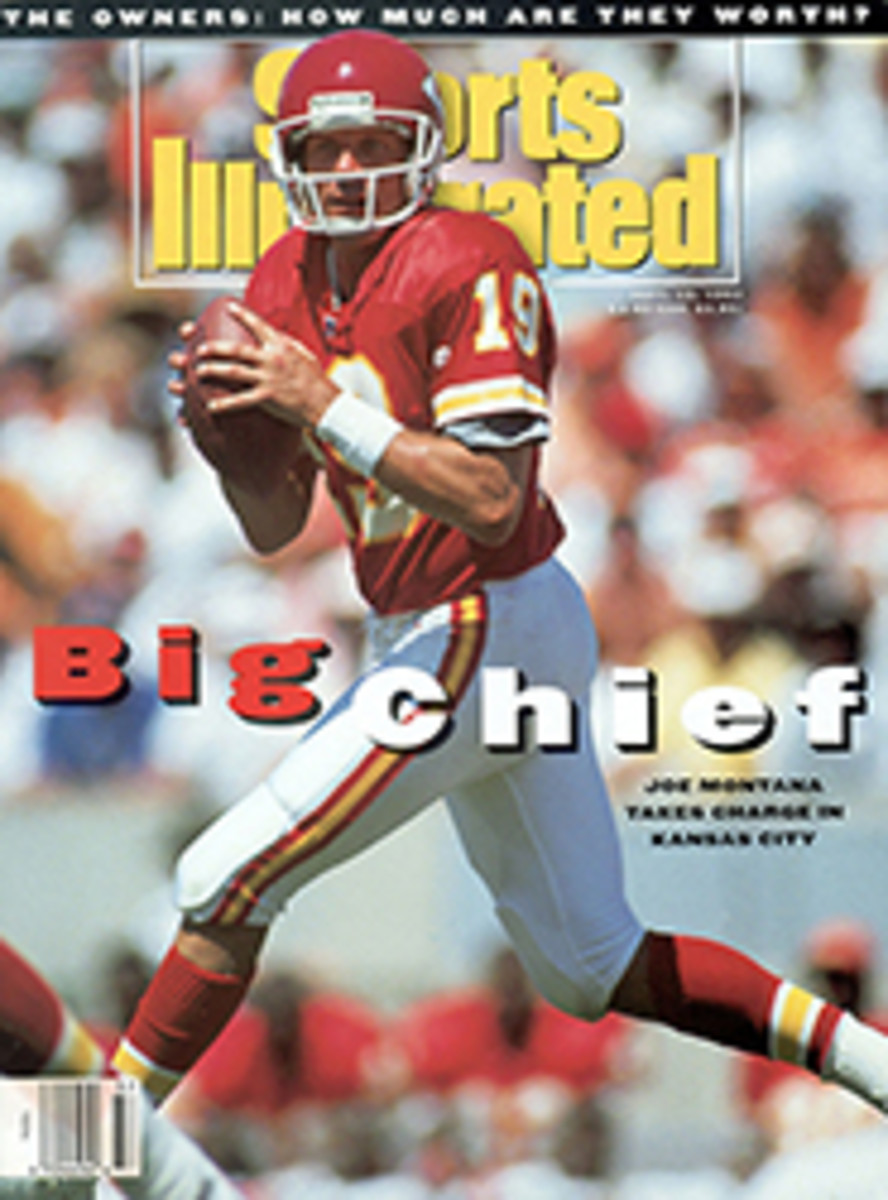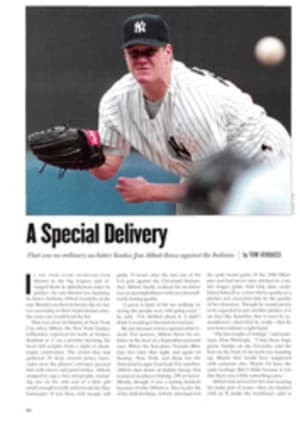
The Big Hurt
I wonder when Oh when will it end The Big Hurt The Big Hurrrrrrt
—MISS TONI FISHER, 1959
The cab pulled up to the players' entrance of Yankee Stadium last Thursday afternoon, and out stepped..."Frank! Frank!" As the fans beseeched him, Frank Thomas worked his way along the police barricades, courteously signing balls and cards. Then he walked down a flight of stairs to the clubhouse level, where he encountered two cleaning men mopping the floor at the foot of the steps.
"Why, it's The Big Hurt!" said one.
"And he's been hurtin' us big," said the other.
As all three men laughed, each worker took hold of one of Thomas's elbows and gingerly guided him across the slick floor. After all, I they had greatness at their fingertips.
Like Miss Toni Fisher, American League pitchers wonder when The Big Hurt will end. After the New York Yankees lost 5-3 to the Chicago White Sox last Wednesday night in a game in which Thomas, the White Sox first baseman, homered for the second straight night and drove in the winning run for the second straight night, a group of Yankees sat in the clubhouse trying to figure out how to pitch to hint. Finally someone offered this sage advice: "We should just walk him every time up. It can't get any worse."
Nor can the 25-year-old Thomas get much better. Through Sunday he was hitting .321 with a franchise-record 40 home runs—including four last week—and a major-league-leading 120 RBIs. Were it not for The Big O, Toronto Blue Jay first baseman John Olerud, who was hitting .379 at week's end, Thomas would have a nice shot at the Triple Crown.
His on-base percentage of .427 was fourth in the American League, and his slugging percentage of .633 was third. He had only eight more strikeouts than homers. One of Thomas's most intriguing—and impressive—stats was this: 15 first-inning home runs. "I call them my school bells," he says. "The offense is in session." The Los Angeles Dodgers have just seven.
In the City of Big Shoulders, only Michael Jordan's are bigger than those of the 6'5", 257-pound Thomas, who is, by the way, a 46 Long. He hasn't carried Chicago to the top of the American League West by himself; it only seems that way. Says Ken (Hawk) Harrelson, the White Sox broadcaster who gave Thomas his nickname two years ago, "Someday soon we will see a team intentionally walk Frank with the bases loaded. And when they do, I will stand up and applaud them for their intelligence. In my 30 years in this game I have never seen anyone like him. In another 30 years we may be talking about Frank Thomas in the same way we talk about Ted Williams."
It's only early September, but Thomas has already had the equal of the MVP year Williams had in 1946 (.342, 38 homers and 123 RBIs). Even though Thomas is a righthanded hitter, he does share with The Thumper certain traits: an uncanny batting eye, for one, and the patience of Job, for another. Other names that Thomas evokes from admirers are Hank Aaron, Dick Allen, Jim Rice.
"The name I often bring up in talking about Frank," says White Sox hitting coach Walt Hriniak, "is Joey Cora." Say what? Cora is the 5'7" Chicago second baseman, who has two career homers—both of them this year. "When I tell people that," continues Hriniak, "I'm trying to make the point that Frank approaches each at bat, each pitch, with a purpose. Nobody on this ball club has a bigger heart than Joey, but Frank comes close. I have never seen him give up an at bat, no matter if we're 10 runs ahead or he's already gotten his four hits or two homers. He has an intense hatred of failure."
Says White Sox leftfielder Tim Raines, one of Thomas's closest friends, "Nobody will ever demand more of Frank than Frank does. He's like Dr. Jekyll and Mr. Hyde. Off the field he's sweet and nice. On the field, well, you should hear some of the things he says about himself after a strikeout."
Thomas has a rather simple explanation for his psyche: "I guess you could say a lot of little hurts went into making The Big Hurt." He grew up in Columbus, Ga., the youngest of Frank and Charlie Mae Thomas's five kids. "I hung out with my older brother and his friends, and I got pushed around a lot until I started pushing back." He starred in the three big sports at Columbus High, but for some reason no baseball team drafted him, so he went to Auburn on a football scholarship. "I would've signed to play baseball, but nobody wanted me. Turned out, though, that Auburn made me a man," Thomas says. After catching three passes as a freshman tight end, he devoted his full athletic attention to baseball. In 1988 he was on the U.S. National Team, but—get this—he was cut before the team went to the Olympics in Seoul. "I couldn't believe it either," says Thomas.
Even after the White Sox made him the seventh pick in the 1989 draft, he had trouble convincing people of how good he was. He made juice out of the Grapefruit League in 1990, but he started the regular season in Double A. The following year, his first full one in the majors, he hit .318 with 32 homers, 109 RBIs and 138 walks, but the Sox still gave him a hard time over his contract.
Last year Thomas batted .323 with 115 RBIs, but he finished eighth in the MVP voting, and some Chicago fans professed disappointment in his 24 home runs. Perhaps they did not realize that he had shared the league lead in doubles, with 46, and that sometimes a Big Hurt double is just a homer that hits the fence while it's still climbing. Says Thomas, "I also got a little tired of hearing 'Yeah, but he can't field.' " So in the off-season Thomas worked on his defense and made himself even stronger through weight training.
The results of that regimen have been readily apparent. While he's not going to remind any Chicagoans of Cap Anson around the bag, he is a damn sight better than Zeke Bonura, the lumbering legend whose club RBI record (138, in 1936) Thomas is chasing. "My favorite moment this year was a play I made at first," Thomas says. "I dove to my right, then threw home to get the runner. I don't think I could have made that play before this year."
There is no question that The Big Hurt has an ego to match. "I just think I should get a hit every time up," he says. He is very much aware of how his home run and RBI competition is doing, and he is quick to point out that "I have had three homers pulled back from over the fence." So when you ask him whom he thinks the American League MVP should be, he is not about to say Olerud. "John's having a great year, an MVP year," says Thomas. "But look at that lineup he's hitting in." So if Thomas ends up the loser in the Baseball Writers Association's Ballot of Frankie and Johnnie, pitchers will be in for a Bigger Hurt next season.
Even if Thomas doesn't win the MVP award, this has been a breakthrough year for him. He is currently negotiating a long-term contract with Chicago because, as he says, "I see myself with the Sox my whole career." He has a new $8 million deal with Reebok, and his handsome, smiling face is becoming increasingly familiar to the American public. He is a big favorite with kids—his rookie baseball card is much valued—because he signs autographs so readily.
Last week Thomas hit a first-inning, two-run homer off Yankee Sterling Hitchcock, which struck him as kind of funny because his one-year-old son is also named Sterling. "What's even funnier," he says, "is that my wife's maiden name is Silver." Frank met Elise Silver two springs ago at the Columbia restaurant in Sarasota, Fla., where the White Sox train. "Melido Perez was hungry, so he made me drive him to the restaurant," says Thomas. "We looked like a couple of bums."
Elise was there with her cousin, in the midst of a visit to spring training sites. The Silvers of Rochester, N.Y., have long been involved with the city's Triple A Red Wings. In fact Silver Stadium in Rochester is named after her great uncle Maury. "I guess you could say we met cute," says Elise. "He bumped into me."
On this night at Yankee Stadium, Elise is sitting with Sterling (who, of course, is wearing Weeboks) and her mother, Lillian, who is an associate dean at Columbia University's Graduate School of Business. There's no need to ask, "What's a nice Jewish girl from Rochester...?" Baseball just has this way of bringing together people like the son of a Columbus, Ga., bail bondsman and a textile worker, and the daughter of a Rochester attorney and an Ivy League administrator.
"People might think there would be some cultural difficulties," says Elise, "but actually, when you come from two loving families, it's pretty easy. Besides, we had baseball in common." So Elise, who grew up cheering for Glenn Gulliver, ended up marrying Frank Thomas. (No, she does not call her husband either Big or Hurt at home.)
"What's the most amazing thing I've seen Frank do?" she says, repeating a question while she watches, amazingly enough, Yankee reliever Paul Assenmacher give up a walk to Cora, thus loading the bases in the eighth inning of a tie game and bringing her husband to the plate. "What amazes me is that he's so good day in and day out." At this point in the conversation another Yankee reliever, Bob Wickman, hits Thomas with his second pitch to force in the winning run. (Presumably Harrelson is standing in the White Sox broadcast booth applauding Wickman for his intelligence.)
"The most amazing thing I've seen Frank do?" says Hriniak. "He's done a lot of amazing things, but this one stands out. A week ago, against the Yankees in Chicago, he hit a ball off Steve Farr in the 10th inning that went right over Farr's head. I thought for sure Bernie Williams, the centerfielder, was going to catch it on a line, but the ball kept rising. If it hadn't hit the seats, it might still be going."
When will it end? The Big Hurt.
PHOTO
CHUCK SOLOMON
TWO PHOTOS
CHUCK SOLOMON
Thomas worked hard in the off-season to improve his play at first base—and it shows.
PHOTO
COURTESY OF ELISE THOMAS
Despite different backgrounds, Frank and Elise, with Sterling, had baseball in common.

